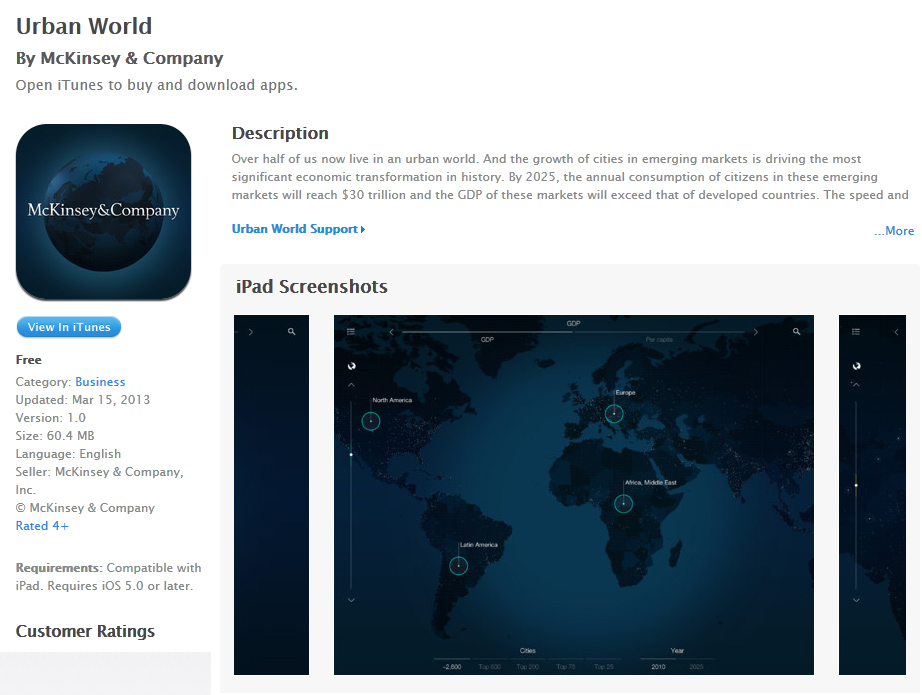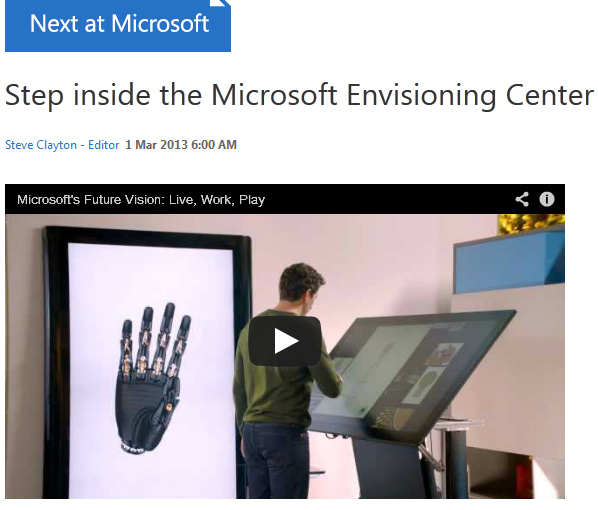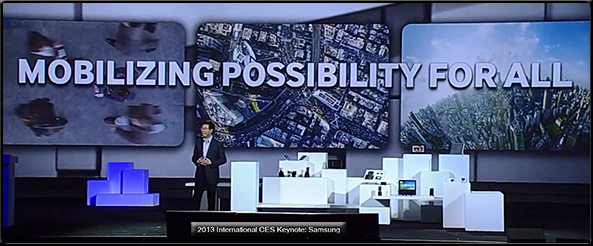Visualizing the future urban world — from fastcoexist.com by Ariel Schwartz
A new app called Urban World beautifully projects how cities around the world are going to explode in growth and economic power by 2025.
Also see:




Visualizing the future urban world — from fastcoexist.com by Ariel Schwartz
A new app called Urban World beautifully projects how cities around the world are going to explode in growth and economic power by 2025.
Also see:
Well, for me, it always boils down to value. People misunderstand this as assigning value based on salaries or employability, but I mean value in the larger sense. You have to have a reason to ask students to pay more than the marginal costs of delivering education. And with all these revolutions in technology for course delivery, that marginal cost is going to zero very, very quickly [think journalism]. So, every institution that’s going to survive, I think, over the next 50 years, is going to have to make that case. Why is it that tuition at this institution is justified?
The interesting thing about this is it’s going to be accelerated because the old bureaucracies, the old institutional models… are crumbling. At least, their boundaries are crumbling. Let me tell you what I mean by that.
The accrediting agencies, which I think traditionally have had — at least for the last 120 years or so—an institutional focus, are now shifting their focus to students; to competencies, to demonstrations of what students know. And that really starts to cut against institutional entitlement.
I think the conclusion of all this is that, as it becomes harder and harder for… a “Me-Too Institution” to argue for a marginal increase in price, the amount of money that those institutions are going to have available to them to spend on anything but core mission for students is also going to go to zero. So, this is kind of a virtuous cycle; … institutions that are unable to make the value proposition will find themselves more and more strapped for discretionary funds in order to move themselves into a different space. And that’s an ending that’s not very good for most institutions.
From DSC:
How will our/your organization keep from becoming a commodity? What are we/you all going to bring to the table that’s different, unique, and worth paying for?
Also see:
Princeton Review founder’s startup Noodle acquires Lore to build an education marketplace around search — from techcrunch.com by Rip Empson
Excerpt:
Last summer, we told you about the launch of Noodle Education, a startup co-founded and led by John Katzman, perhaps better known as a co-founder of The Princeton Review and 2U (formerly 2tor). The startup is on a mission to bring a Netflix-style recommendation engine to the fragmented and noisy world of education. Not unlike Google, Noodle Education wants to organize the world’s learning platforms and aggregate the huge amount of educational info out their on the Web into a learning-centric, personalized search and recommendation engine.
IBM CEO predicts three ways technology will transform the future of business — from forbes.com by Jenna Goudreau

Virginia Rometty
“The greatest contribution of this shift,” Rometty concluded,
“is that it will force every entity to become an authentic organization.”
Excerpt:
It’s not unusual for a science fiction television show to spin off a video game. What is unusual is linking the show and the game together on an ongoing basis, with plot elements and characters from each crossing over to the other. In April, gaming company Trion Worlds and the Syfy cable television channel will unveil Defiance, the first such crossover massively multiplayer online game (MMO) and TV show.
From DSC:
Transmedia.
Multimedia.
Interactivity.
Participation.
Gamification.
Sounds like there must be something here for the next gen of learners — and learning from the living room.
Also see:
From DSC:
Below are some reflections after seeing these items:
.
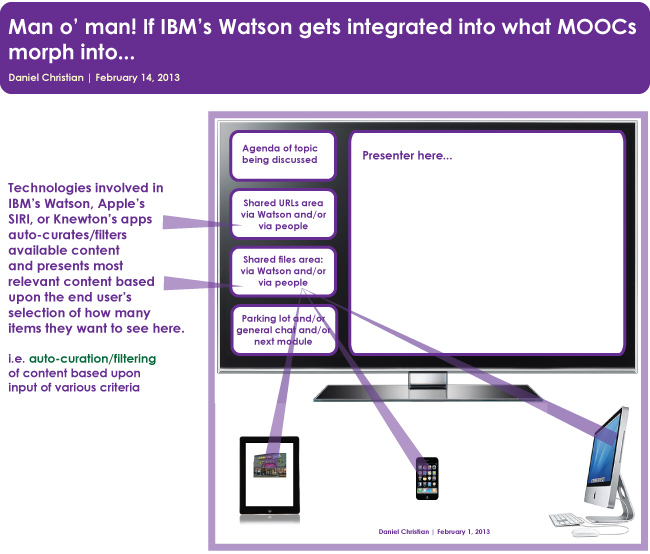
From DSC:
The current set of MOOCs are very powerful, but, like a bush that needs pruning, they can become unwieldy and hard to control. Not only do the current set of MOOCs help me to see the importance of instructional design, but trying to drink from the firehose often presents problems (i.e. wading through thousands of tweets, hundreds of blog posts, etc.). How can we still provide openness and yet provide people with better methods/tools for setting their desired level of drinking from this firehose? Tags are helpful, but for most people, they are not doing enough to filter/curate the content at this point.
Enter the technologies being developed in IBM’s Watson, Apple’s SIRI, or in Knewton’s product lines. End-user controllable setting might include:
The ideas involving learning agents, artificial intelligence, intelligent tutoring, intelligent systems and more seem to get roped in here…hmm…just thinking out loud and sharing potentially-useful ideas.
College branding: The tipping point — from forbes.com by Roger Dooley
Excerpt:
Change is coming to this market. While there are multiple issues of increasing importance to schools, two stand out as major game-changers.
From DSC:
Important notes for the boards throughout higher education to consider:
Your institution can’t increase tuition by one dime next year. If you do, you will become more and more vulnerable to being disrupted. Instead, work very hard to go in the exact opposite direction. Find ways to discount tuition by 50% or more — that is, if you want to stay in business.
Sounds like the scene in Apollo 13, doesn’t it? It is. (i.e. as Tom Hanks character is trying to get back to Earth and has very little to do it with. The engineers back in the United States are called upon to “do the impossible.”)
Some possibilities:
- Pick your business partners and begin pooling resources and forming stronger consortia. Aim to reduce operating expenses, share the production of high-quality/interactive online courses, and create new streams of income. Experimentation will be key.
- Work with IBM, Apple, Knewton and the like to create/integrate artificial intelligence into your LMS/CMS in order to handle 80% of the questions/learning issues. (Most likely, the future of MOOCs involves this very sort of thing.)
- Find ways to create shorter courses/modules and offer them via online-based exchanges/marketplaces. But something’s bothering me with this one..perhaps we won’t have the time to develop high-quality, interactive, multimedia-based courses…are things moving too fast?
- Find ways to develop and offer subscription-based streams of content
From DSC:
First, what prompted the questions and reflections that are listed below? For that, I turn to some recent items that I ran across involving the use of robotics and whether that may or may not be affecting employment:
The work of Erik Brynjolfsson and Andrew McAfee; for example their book Race Against the Machine
Excerpt of description:
But digital innovation has also changed how the economic pie is distributed, and here the news is not good for the median worker. As technology races ahead, it can leave many people behind. Workers whose skills have been mastered by computers have less to offer the job market, and see their wages and prospects shrink. Entrepreneurial business models, new organizational structures and different institutions are needed to ensure that the average worker is not left behind by cutting-edge machines.
How to freak out responsibly about the rise of the robots — from theatlantic.com by Derek Thompson
It’s fun to imagine an economy where machines are smarter than humans. But we don’t need an artificial crisis over artificial intelligence.
Excerpt:
Let’s say it upfront: Technology can replace jobs and (at least temporarily) increase income inequality. From the spinning jenny to those massive mechanical arms flying wildly around car assembly lines, technology raises productivity by helping workers accomplish more in less time (i.e.: put a power drill in a human hand) and by replacing workers altogether (i.e.: build a power-drilling bot).
…
What ails us today isn’t a surplus of robots, but a deficit of demand. Yes, we have a manufacturing industry undergoing a sensational, but job-killing, productivity revolution — very much like the one that took farm employment from 40 percent in 1900 to less than 5 percent today. But the other nine-tenths of the economy are basically going through an old-fashioned weak-but-steady recovery, the kind that hundreds of years of financial crises would predict.
America has hit “peak jobs” — from techcrunch.com by Jon Evans
Excerpt:
“The middle class is being hollowed out,” says James Altucher. “Economists are shifting their attention toward a […] crisis in the United States: the significant increase in income inequality,” reports the New York Times.
Think all those job losses over the last five years were just caused by the recession? No: “Most of the jobs will never return, and millions more are likely to vanish as well, say experts who study the labor market,” according to an AP report on how technology is killing middle-class jobs.
Technology and the employment challenge — from project-syndicate.org by Michael Spence
Excerpt:
MILAN – New technologies of various kinds, together with globalization, are powerfully affecting the range of employment options for individuals in advanced and developing countries alike – and at various levels of education. Technological innovations are not only reducing the number of routine jobs, but also causing changes in global supply chains and networks that result in the relocation of routine jobs – and, increasingly, non-routine jobs at multiple skill levels – in the tradable sector of many economies.
Man vs. robot — from macleans.ca by Peter Nowak
.
.
Secondly, some reflections (from DSC)
I wonder…
Again, for me, the answer lies at least partly in helping people consistently obtain the knowledge that they need — i.e. to help them build, grow, and maintain their own learning ecosystems — throughout their lifetimes. We need to help people dip their feet into the appropriate streams of content that are constantly flowing by.
Perhaps that’s one of the key new purposes that K-12, higher ed, and the corporate training departments out there will play in the future as they sift through the massive amounts of information coming at us to help individuals identify:
.
From DSC:
As a team of us have been charged with putting together a new collaborative workspace/conference room, I’ve been thinking about some ideas for a new type of interface as well as some new types of Human Computer Interaction (HCI) to be used in group collaboration/web-based collaboration. I was thinking it would be good to not only display files from various devices but also to be able to share files/URLs/other resources with each other. (Some type of storage device that processes files — and scans them for viruses would be needed in addition to a large display or an interactive multitouch surface/wall.)
People within the same room could contribute files/items to a variety of “areas” — and so could others who joined in via the Internet. Here’s what I had wanted to be able to do and I had pictured in my mind:

ADDITIONAL NOTES:
.
It’s very similar to what Tidebreak has created/envisioned in their product lines.
Check out their innovative work/products/concepts!
Transforming learning spaces: 3 big ideas — from Tidebreak
Also see:
The object formerly known as the textbook –– from The Chronicle by Jeff Young
.
Excerpt:
Textbook publishers argue that their newest digital products shouldn’t even be called “textbooks.” They’re really software programs built to deliver a mix of text, videos, and homework assignments. But delivering them is just the beginning. No old-school textbook was able to be customized for each student in the classroom. The books never graded the homework. And while they contain sample exam questions, they couldn’t administer the test themselves.
One publisher calls its products “personalized learning experiences,” another “courseware,” and one insists on using its own brand name, “MindTap.” For now, this new product could be called “the object formerly known as the textbook.”
From DSC:
Imagine how this sort of thing might fit into the “chalkboard of the future” — as applications and content flow onto the “board” from open source repositories and/or from the publishers’ cloud-based repositories of content…
.
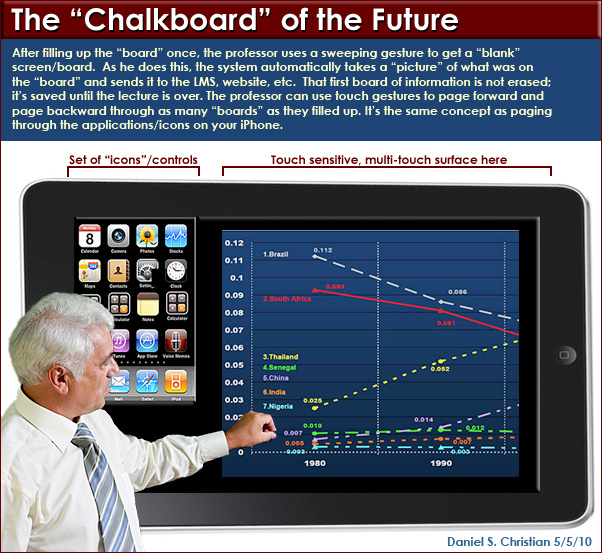
.
or in learning from the living room…
.
![The Living [Class] Room -- by Daniel Christian -- July 2012 -- a second device used in conjunction with a Smart/Connected TV](http://danielschristian.com/learning-ecosystems/wp-content/uploads/2012/07/The-Living-Class-Room-Daniel-S-Christian-July-2012.jpg)
Also see:
From DSC:
In real estate, one hear’s the mantra:
Location. Location. Location.
In higher education, I have it that we’ll be hearing this for a while:
Experimentation. Experimentation. Experimentation.
Consider the following reflections on Steve’ Kolowich’s solid article, The new intelligence (from InsideHigherEd.com)
Excerpt:
And for the largest public university in the country, it is hardly fiction. Arizona State University has become ground zero for data-driven teaching in higher education. The university has rolled out an ambitious effort to turn its classrooms into laboratories for technology-abetted “adaptive learning” — a method that purports to give instructors real-time intelligence on how well each of their students is getting each concept.
.
From DSC:
Besides being used in blended learning environments…some predictions:
It’s the sort of thing I was trying to get at with this graphic from 3 years ago:
.
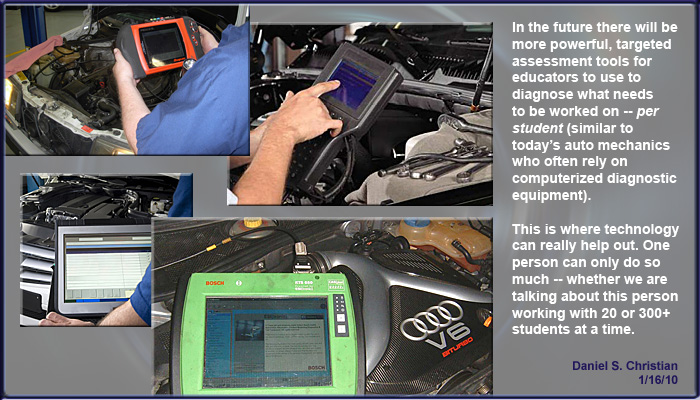
Please don’t misunderstand me, the human mind is far beyond the complexity of an engine. But I still think that there will be more tools & technologies developed that will help the teachers/professors in their efforts to guide students into the knowledge of a discipline.
I beseech the corporate world to get involved more here — and not with the end goal of earning profits — but rather, with the aim of making the world a better place and giving a huge gift to the generations yet born.
I urge the corporate world to reach into their deep pockets (1.X trillion in cash at this point in time) and team up with our youth/teachers/professors/instructional designers/programmers/etc. to develop sophisticated, educationally-related, engaging games that are relevant to the world that our youth will be growing up in; and/or create interactive simulations that provide more choice/more control to the learners.
I urge more of the corporate world to join Knewton and Pearson and allocate some significant resources to help develop the next gen learning tools. I’ll bet that we’ll be amazed at what can be produced! Your daughters, sons, granddaughters, and grandsons will really appreciate the work that you did for them!!!
A tale of two television strategies — from IEEE.org by Steven Cherry
Excerpt:
At the 2013 Consumer Electronics Show, back-to-back visits to LG and Panasonic reveal two very different approaches to selling, and maybe making, televisions. At LG the focus was on display technologies, picture quality, size, and form factors. Panasonic put its Smart TV features front and center.
…
I saw a voice-commanded Google search.
…
At yet another station, Panasonic showed a proof-of-concept of some friends all chatting by text message (like an old-style AOL chatroom), with the messages showing up on at the bottom portion of a television screen showing the program that everyone is watching.
…
LG had a few user scenarios—collaborative picture drawing between users of 5-inch tablets, for example—but they mostly weren’t very well developed, nor very smart.
.
Also see:
8 things to look for in today’s classroom — by George Couros
Excerpt:
As I think that leaders should be able to describe what they are looking for in schools I have thought of eight things that I really want to see in today’s classroom. I really believe that classrooms need to be learner focused. This is not simply that students are creating but that they are also having opportunities to follow their interests and explore passions. The teacher should embody learning as well.
From DSC:
If we can tap into students’ passions/hearts, I believe we’ll find enormous amounts of creative energy pour forth! I’m again struck with adding the tags/keywords to this posting — More choice, more control.
